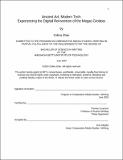Ancient Art, Modern Tech: Experiencing the Digital Reinvention of the Mogao Grottoes
Author(s)
Zhao, Celina
DownloadThesis PDF (1.689Mb)
Advisor
Levenson, Thomas
Terms of use
Metadata
Show full item recordAbstract
Built from the 4th to 14th century, the Mogao Grottoes in the deserts of northwestern China is the greatest repository of Buddhist art in the world. It has long faced a range of threats from natural disasters to imperialistic plunder. But now it must confront the greatest challenge to its continued existence: modern-day tourism. The sheer volume of visitors seeking a direct experience of this unique but delicate site has resulted in an increasingly rapid process of destruction in the 21st century.
Its guardian institution, the Dunhuang Academy (DA), has thus embarked on an ambitious, decades-long undertaking that puts technology at the core of its mission to protect, research, and promote the site. Today, digital resources, replicas, and exhibitions have redefined what it means to experience the caves. Together, they have also expanded Mogao’s reach far beyond its physical boundaries.
Against all odds, this middle-of-nowhere desert outpost has emerged as a global pioneer of digital conservation and restoration. It’s a model that can be exported to other fragile sites across the world. This thesis compiles a comprehensive history of Dunhuang’s journey and raises questions about what it means to “authentically experience” such cultural heritage today.
Date issued
2024-05Department
Massachusetts Institute of Technology. Program in Comparative Media Studies/WritingPublisher
Massachusetts Institute of Technology